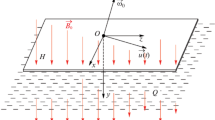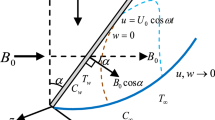Abstract
The effect of a magnetic field on thermal instability in mixed convection flow on a heated rotating convex surface is studied in this paper. The onset position characterized by the Goertler number G δ depends on the Grashof number, the rotational number, the Prandtl number, the magnetic field parameter, and the wave number. The buoyancy force, the centrifugal force, the Lorentz force, and the Coriolis force are found to significantly affect the flow structure and heat transfer of the flow. Negative rotation (clockwise) destabilizes the boundary layer flow on a convex surface. However, the Lorentz force stabilizes the flow. Numerical data in this study show the same order of magnitude like experimental data.
Similar content being viewed by others
Abbreviations
- a′:
-
Dimensional wave number, a′ = 2π/λ (1/m)
- (a′δ)mod :
-
Modified wave number, defined in Eq. (28)
- a :
-
Dimensionless wave number, a = a′R/Re 1/2
- B 0 :
-
The uniform magnetic field strength (Wb/m 2)
- C f :
-
Local friction factor
- F :
-
Velocity, pressure or temperature function
- f :
-
The reduced stream function, ψ(ν XU ∞)−1/2
- g :
-
Gravity acceleration (m/s2)
- Gr :
-
The Grashof number, \({Gr=\frac{g\beta (T_w -T_\infty )R^{3}}{\nu^{2}}}\)
- Gr X :
-
Local Grashof number, \({Gr_X =\frac{g\beta (T_w -T_\infty )X^{3}}{\nu^{2}}}\)
- G :
-
The Goertler number based on the radius of curvature of the convex surface, G = 2R Re 1/2
- G L :
-
The Goertler number based on the characteristic length of the flat plate, \({G=2L{Re}_L^{1/2}}\)
- G X :
-
Local Goertler number, \({G_X =2X{Re}_X^{1/2} /R=G\times x^{3/2}}\)
- G δ :
-
Local Goertler number based on the boundary layer thickness, defined in Eq. (26)
- h :
-
Local heat transfer coefficient (W/m 2 K)
- Ha :
-
The Hartmann number, \({Ha^{2}=\frac{\sigma B_0^2 R^{2}}{\rho \nu}}\)
- L :
-
The characteristic length of the flat plate
- M :
-
The magnetic field parameter, \({M=\frac{\sigma B_0^2 R}{\rho U_\infty}=\frac{Ha^{2}}{{Re}}}\)
- p′, p:
-
Dimensional and dimensionless pressure, \({{p}'=\rho U_\infty^2 p/{Re}}\) (N/m2)
- Pr :
-
The Prandtl number, ν/α
- Nu X :
-
Local Nusselt number, hX/k
- R :
-
Radius of curvature (m)
- Ro :
-
Rotational number, Ω R/U ∞
- Re :
-
The Reynolds number, U ∞ R/ν
- Re L :
-
The Reynolds number based on the characteristic length of the flat plate, U ∞ L/ν
- Re X :
-
Local Reynolds number, U ∞ X/ν
- T :
-
Temperature (K)
- t′, t:
-
Dimensional and dimensionless perturbation temperature, t′ = (T w − T ∞)t
- t°:
-
Initial constant perturbation temperature at x = 0
- U, V, W :
-
Dimensional velocity components (m/s)
- u, v, w:
-
Dimensionless perturbation velocity components
- u′, v′, w′:
-
Perturbation velocity components (m/s)
- X, Y, Z :
-
Curvilinear coordinates (m)
- x, y, z:
-
Dimensionless curvilinear coordinates
- α :
-
Thermal diffusivity of fluid (m2/s)
- β :
-
The coefficient of thermal expansion (1/K)
- δ :
-
Boundary layer thickness (m)
- η :
-
The similarity variable, \({YRe_X^{1/2} /X}\)
- θ b :
-
Dimensionless basic temperature, (T − T ∞)/(T w − T ∞)
- λ :
-
The wavelength in Z-direction (m)
- σ :
-
Electrical conductivity, (mho/m)
- τ :
-
The elapsed time (s)
- τ w :
-
Local wall shear stress
- ν :
-
Kinematic viscosity of the fluid (m2/s)
- ξ :
-
Vorticity function in X-direction (1/s)
- ψ :
-
Stream function (m2/s)
- Ω:
-
Angular speed ( rad/s)
- *:
-
Onset position
- b :
-
Basic flow quantity
- p :
-
Perturbation quantity
- w :
-
Surface condition
- X :
-
Local coordinate
- ∞:
-
Free stream condition
References
Bejan A.: Heat Transfer. 1st edn. Wiley, New York (1993)
Chen C.T., Lin M.H.: Effect of rotation on Goertler vortices in the boundary layer flow on a curved surface. Int. J. Numer. Methods Fluids 40, 1327–1346 (2002)
Hwang G.J., Lin M.H.: Estimation of the onset of longitudinal vortices in a laminar boundary layer heated from below. ASME J. Heat Transf. 117, 835–842 (1995)
Jean, J.F.: Visualization of Vortices in a Rotating Concave-Rectangular Passage. Ms. Thesis, National Tsing-Hwa University, Taiwan, ROC (1997)
Lee S.L.: Weighting function scheme and its application on multidimensional conservation equations. Int. J. Heat Mass Transf. 32, 2065–2073 (1982)
Lin, C.H.: Visualization of Vortex Instability in Radically Rotating Rectangular Channel. Master thesis, National Tsing-Hwa University, Taiwan (1996)
Lin M.H., Hwang G.J.: Numerical study of formation of longitudinal vortices in a laminar boundary layer with rotation. J. Chin. Soc. Mech. Eng. 2, 341–349 (2000)
Lin M.H., Chen C.T.: Study on the formation of Goertler vortices in natural convection flow over a rotating concave surface. Appl. Math. Comput. 169, 778–796 (2005)
Lin M.H., Chen C.T.: Study of thermal instability in natural convection flow over a rotating convex surface. J. Enhan. Heat Transf. 12, 259–272 (2005)
Lin M.H., Chen C.T.: Study of thermal instability in mixed convection flow over a rotating convex surface. J. Chin. Soc. Mech. Eng. 17, 343–351 (2006)
Lin M.H.: Thermal instability in natural convection flow over a rotating convex surface subject to external magnetic field. Appl. Math. Comput. 198, 511–525 (2008)
Lin M.H.: Magnetic effect on the formation of longitudinal vortices in natural convection flow over a rotating laminar boundary layer. Appl. Math. Model. 32, 547–561 (2008)
Lin M.H., Chen C.T.: Magnetic effect on the formation of longitudinal vortices in natural convection flow over a horizontal plate. J. Aeronaut. Astron. Aviat. 39, 145–152 (2007)
Matsson O.J.E., Alfredsson P.H.: The effect of spanwise system rotation on dean vortices. J. Fluid Mech. 274, 243–265 (1994)
Matsson O.J.E.: Experiments on streamwise vortices in curved wall jet flow. Phys. Fluids 7, 2978–2988 (1995)
Matubara, M., Masuda, S.: Three-Dimensional Instability in Rotating Boundary Layer. FED-Vol. 114, ASME, Boundary layer stability and transition to turbulence, pp. 103–107 (1991)
Mutabazi I., Normand C., Wesfreid J.E.: Gap size effects on centrifugally and rotationally driven instabilities. Phys. Rev. A 4, 1199–1205 (1992)
Selmi A., Nandakumar K., Finley W.H.: A bifurcation study of viscous flow through a rotating concave duct. J. Fluid Mech. 262, 353–375 (1994)
Wang L., Cheng K.C.: Flows in concave channel with a low negative rotation speed. Phys. Rev. E 51, 1155–1161 (1995)
Wang L., Cheng K.C.: Flow transitions and combined free and forced convective heat transfer in rotating concave channels: the case of positive rotation. Phys. Fluids 8, 1553–1573 (1996)
Wang L.: The effect of negative spanwise rotation on dean vortices. ASME J. Fluids Eng. 119, 718–721 (1997)
Wang L.: Buoyancy-force–driven transitions in flow structures and their effects on heat transfer in a rotating concave channel. Int. J. Heat Mass Transf. 40, 223–235 (1997)
White, F.M.: Viscous Fluid Flow, 2nd edn., p. 378. McGraw-Hill, New York (1991)
Author information
Authors and Affiliations
Corresponding author
Rights and permissions
About this article
Cite this article
Chen, CT. Thermal instability of a rotating curved plate subjected to an applied magnetic field. Acta Mech 214, 343–356 (2010). https://doi.org/10.1007/s00707-010-0289-6
Received:
Revised:
Published:
Issue Date:
DOI: https://doi.org/10.1007/s00707-010-0289-6




